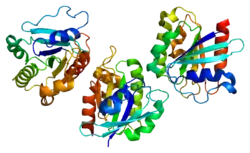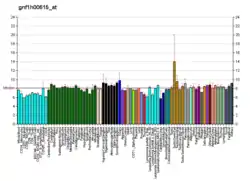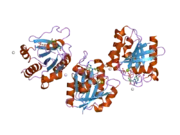ARL6
ADP-ribosylation factor-like protein 6 is a protein that in humans is encoded by the ARL6 gene.[5][6][7]
The protein encoded by this gene belongs to the ARF family of GTP-binding proteins. ARF proteins are important regulators of cellular traffic and are the founding members of an expanding family of homologous proteins and genomic sequences. They depart from other small GTP-binding proteins by a unique structural device that implements front-back communication from the N-terminus to the nucleotide-binding site. Studies of the mouse ortholog of this protein suggest an involvement in protein transport, membrane trafficking, or cell signaling during hematopoietic maturation. Alternative splicing occurs at this locus and two transcript variants encoding the same protein have been described.[7]
References
- GRCh38: Ensembl release 89: ENSG00000113966 - Ensembl, May 2017
- GRCm38: Ensembl release 89: ENSMUSG00000022722 - Ensembl, May 2017
- "Human PubMed Reference:". National Center for Biotechnology Information, U.S. National Library of Medicine.
- "Mouse PubMed Reference:". National Center for Biotechnology Information, U.S. National Library of Medicine.
- Chiang AP, Nishimura D, Searby C, Elbedour K, Carmi R, Ferguson AL, Secrist J, Braun T, Casavant T, Stone EM, Sheffield VC (Jul 2004). "Comparative genomic analysis identifies an ADP-ribosylation factor-like gene as the cause of Bardet-Biedl syndrome (BBS3)". Am J Hum Genet. 75 (3): 475–84. doi:10.1086/423903. PMC 1182025. PMID 15258860.
- Fan Y, Esmail MA, Ansley SJ, Blacque OE, Boroevich K, Ross AJ, Moore SJ, Badano JL, May-Simera H, Compton DS, Green JS, Lewis RA, van Haelst MM, Parfrey PS, Baillie DL, Beales PL, Katsanis N, Davidson WS, Leroux MR (Sep 2004). "Mutations in a member of the Ras superfamily of small GTP-binding proteins causes Bardet-Biedl syndrome". Nat Genet. 36 (9): 989–93. doi:10.1038/ng1414. PMID 15314642.
- "Entrez Gene: ARL6 ADP-ribosylation factor-like 6".
External links
- GeneReviews/NIH/NCBI/UW entry on Bardet-Biedl Syndrome
- Human ARL6 genome location and ARL6 gene details page in the UCSC Genome Browser.
- Overview of all the structural information available in the PDB for UniProt: Q9H0F7 (Human ADP-ribosylation factor-like protein 6 (ARL6)) at the PDBe-KB.
Further reading
- Sheffield VC, Carmi R, Kwitek-Black A, et al. (1995). "Identification of a Bardet-Biedl syndrome locus on chromosome 3 and evaluation of an efficient approach to homozygosity mapping". Hum. Mol. Genet. 3 (8): 1331–5. doi:10.1093/hmg/3.8.1331. PMID 7987310.
- Bonaldo MF, Lennon G, Soares MB (1997). "Normalization and subtraction: two approaches to facilitate gene discovery". Genome Res. 6 (9): 791–806. doi:10.1101/gr.6.9.791. PMID 8889548.
- Jacobs S, Schilf C, Fliegert F, et al. (1999). "ADP-ribosylation factor (ARF)-like 4, 6, and 7 represent a subgroup of the ARF family characterization by rapid nucleotide exchange and a nuclear localization signal". FEBS Lett. 456 (3): 384–8. doi:10.1016/S0014-5793(99)00759-0. PMID 10462049. S2CID 84422541.
- Ingley E, Williams JH, Walker CE, et al. (1999). "A novel ADP-ribosylation like factor (ARL-6), interacts with the protein-conducting channel SEC61beta subunit". FEBS Lett. 459 (1): 69–74. doi:10.1016/S0014-5793(99)01188-6. PMID 10508919. S2CID 30948975.
- Hartley JL, Temple GF, Brasch MA (2001). "DNA cloning using in vitro site-specific recombination". Genome Res. 10 (11): 1788–95. doi:10.1101/gr.143000. PMC 310948. PMID 11076863.
- Wiemann S, Weil B, Wellenreuther R, et al. (2001). "Toward a catalog of human genes and proteins: sequencing and analysis of 500 novel complete protein coding human cDNAs". Genome Res. 11 (3): 422–35. doi:10.1101/gr.GR1547R. PMC 311072. PMID 11230166.
- Pasqualato S, Renault L, Cherfils J (2003). "Arf, Arl, Arp and Sar proteins: a family of GTP-binding proteins with a structural device for 'front-back' communication". EMBO Rep. 3 (11): 1035–41. doi:10.1093/embo-reports/kvf221. PMC 1307594. PMID 12429613.
- Strausberg RL, Feingold EA, Grouse LH, et al. (2003). "Generation and initial analysis of more than 15,000 full-length human and mouse cDNA sequences". Proc. Natl. Acad. Sci. U.S.A. 99 (26): 16899–903. Bibcode:2002PNAS...9916899M. doi:10.1073/pnas.242603899. PMC 139241. PMID 12477932.
- Gerhard DS, Wagner L, Feingold EA, et al. (2004). "The status, quality, and expansion of the NIH full-length cDNA project: the Mammalian Gene Collection (MGC)". Genome Res. 14 (10B): 2121–7. doi:10.1101/gr.2596504. PMC 528928. PMID 15489334.
- Wiemann S, Arlt D, Huber W, et al. (2004). "From ORFeome to biology: a functional genomics pipeline". Genome Res. 14 (10B): 2136–44. doi:10.1101/gr.2576704. PMC 528930. PMID 15489336.
- Rual JF, Venkatesan K, Hao T, et al. (2005). "Towards a proteome-scale map of the human protein-protein interaction network". Nature. 437 (7062): 1173–8. Bibcode:2005Natur.437.1173R. doi:10.1038/nature04209. PMID 16189514. S2CID 4427026.
- Mehrle A, Rosenfelder H, Schupp I, et al. (2006). "The LIFEdb database in 2006". Nucleic Acids Res. 34 (Database issue): D415–8. doi:10.1093/nar/gkj139. PMC 1347501. PMID 16381901.






